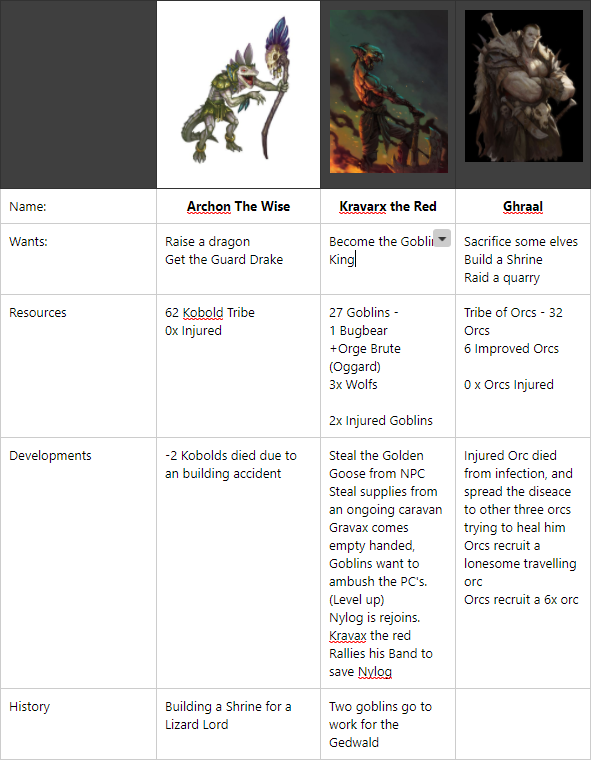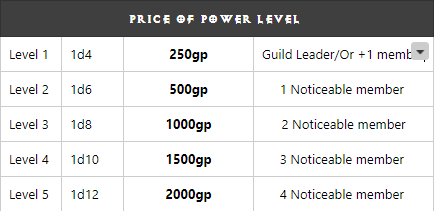How To Run Your Villains Organically
Look, there are many ways to create conflict with your villains. Sometimes Dungeon Masters get a little bit overboard giving reacquiring Villians more powers, followers and other things that make your players go - what? Today I will be dwelling on how to run your villains organically, create more conflict in your campaign, and have more fun while doing so.
So, I use a system, because everybody likes systems. I made this system, and it's far from perfect. But maybe it can inspire you in the process of running your villains.
At first, let's make a list of exciting villains for my campaign that I want to run. It could be bandits, fiends, goblins, or whatever you want and just put it in a Sheet. Writing everything down in one sheet gives me a complete picture, all of them and their intentions. For this example, I will put three low-level villains for my campaign - Kravarx the Red, a cunning goblin warlord, Archon The Wise - Kobold High Priest, and Ghraal - Orc Chieftain.
The Power Die System
When I put them on a list, I can see that they want different things. And as a DM, I need to breed some conflicts, and I give them some starting resources for the campaign. From that point, I set in stone those resources. I tend to loosely calculate the resources/manpower that the party could potentially defeat after a couple of combats or by solving the issues, a.k.a. - Quests. Now, in the end, I give them two things, which are the development and history sections. The "developments" is a section that happens after the session ends, and that is determined by the - Power Die. The Power Die - Dices that go up in levels, starting with 1d4 up to 1d20 in the long run. So a small goblin tribe that leader is rather weak could have a low power dice - 1d4 and a Lich on the other hand, probably 1d20 or even more.
And History is what happened with the party and a particular villain, but we will review that a bit later.
So, why do I need to use this Power Die? Well, after the session ends and your party went on a wild goose chase(Like my party, always) after the session, I enjoy playing with my villains by looking at what they would want and deciding on some course of action they should take. For example, Ghraal and Archon wish to build a shrine, but they need materials, logically, they would want to get them. They could start to steal, pillage, and do other things to get it and if they succeed - Roll a Power Die. The shrine could need 18 Resources to complete. So, you roll 1d6 if they are successful by rolling d20. For example, you roled six, and that is 6/18 materials you need to complete the shrine.
The same thing happens if the party just mangled the goblins after a couple of encounters and need some reinforcements to muster - Roll a power Die, and here you go, the Villian has been recruiting after the session ended.
This approach gives you a chance to think more strategically with your villains. Maybe Archon gets recked by the party and forms a pact with the Kravarx so they could be strong in numbers or even help the Goblin to become King and summon a dragon safely for himself. Seeing what happens every session and afterward simulate situations that you haven't thought at the start, and it breeds new conflicts, which your party members can explore.
But what if the villain fails? Maybe that gives the party an opening? Or some Villians resources dwindle in the process, for instance - In my campaign Ghraal wanted more gold to get better weapons for his tribe(I know he could steal it, but he was few in numbers). He ambushed the caravan and rolled natural 20. Okay, I will double the Power Die result and then maybe see if the Orcs managed to hide their tracks... rolled 18... Well, that's interesting. My players during a session encounter a wagon that was recently attacked and decided to investigate, and DC was 18 for the players. They failed multiple checks, and they decided it was the goblins. There you go fun, right? Now they gonna bust goblin balls for killing people at the wagon and goblins are like why do you look at us? It feels organic. It gets convoluted, but you still see how things are going at your sheet. Having this approach creates more opportunities for you to write your story. After a session, even if the party hasn't encountered a villain - they are still there doing something. Always advancing or failing in some capacity. I love that as a DM because it gives me incredible ways to move the story without breaking my brain every single time, thinking about what a villain would do.
The Power Die
The Power Die can represent different results, whether that is recruits, resources obtained, or other various things, but what a Villian should always want(As a DM) is to increase the Power Die, and how would you go about it? I made this chart for myself, it can be gold, it could be souls it could be anything that fits your Villian, but generally, I use this block to improve the Power Die.
Another thing is that sometimes, villains lack interesting henchmen. That is why I set some boundaries for myself if the villain is low level - he probably will be for himself and maybe a couple of recruits. However, every time the villain upgrades his Power die, I give him another character, a noticeable member that can also wield another power die of the same nature. Remember the shrine example? Now there are two characters - Archon, and another Kobold, maybe a Tunnel Engineer or whatever character you can think of, you give him stats, and if they both want to build the shrine, that's 2d6 to achieve their goal to create a shrine. This method scales pretty well during the campaign, and unattended villains become a force of nature in the end, even if they are a bunch of Kobolds.
History
So your players get to know one or another of the Villians, interact with them and their minions, unfold their plans or try to stop them. A history section is a place where I put the interactions that occurred. Writing down these moments acts as a reminder for myself. Also, it gives me all the juicy details to remember against the party and plan my next moves as a DM.
So there it is, that's is how I run my villains organically, I hope this inspires you to create your own system, and use it effectively at your table. Now today, we just had three villains with not that much of the information and things for the sake of clarity, but imagine when there are 6-10 or even more villains running around the campaign doing their treacherous activities in small steps. This approach is also great to connect all of the PC's backstories and their arch-villains and advance them in the game. In this way, the PC's will feel their presence always, and you can throw them off their feet by offering small tit-bits of another villain actions instead.
If you enjoyed this article and want to see more of Dungeon Goblin content, consider supporting us by making a direct donation through our blog or supporting us on Patreon. Dungeon Goblin is a new blog, and your support matters immensely to us. We want you to become one of the first Dungeon Goblin supporters and grow it into something amazing one day. Thank you for reading!





